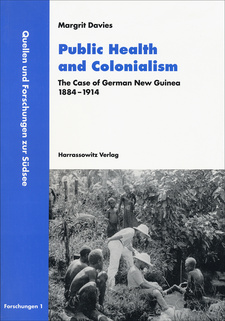Public Health and Colonialism. The Case of German New Guinea 1884–1914, by Margrit Davies

Public Health and Colonialism. The Case of German New Guinea 1884–1914, by Margrit Davies. Harrassowitz 2002. ISBN 3447046007 / ISBN 3-447-04600-7 / ISBN 9783447046008 / ISBN 978-3-44-704600-8
Public Health and Colonialism. The Case of German New Guinea 1884–1914, by Margrit Davies is a study of the evolution of public health policies in New Guinea during the thirty years of German colonisation, from annexation in 1884 to the occupation by Australian troops in September 1914.
The Protectorate of the New Guinea Company was established with the grant of an Imperial Charter to the company in 1885. It consisted of the north-eastern part of mainland New Guinea, which was called Kaiser-Wilhelmsland, and the Bismarck Archipelago (the chain of islands to the north and northeast). In 1886 the northern section of the Solomon Islands (the Shortland Islands, Buka, Bougainville, Santa Isabel and Choiseul) were added. With the transfer of power from the New Guinea Company to the Reich in 1899, the territory became the Imperial Colony of German New Guinea. As part of the Samoa Agreement in 1900 there was a border realignment in the northern Solomons and only Buka and Bougainville remained German. These Melanesian possessions became known as the "Old Protectorate" when the so-called "Island Territory", comprising the Mariana and Caroline Islands (purchased from Spain in 1898), was incorporated into the administration. In 1906 the Marshall Islands, a German Protectorate which included Nauru, was also incorporated into German New Guinea. A comprehensive study of the wider territory called German New Guinea was not possible, and I concentrate my study on the Old Protectorate. A focus on Kaiser-Wilhelmsland and the Bismarck Archipelago seemed appropriate. This was a distinct administrative unit in German times, and its coastal regions which was - as far as German control extended - shared a common epidemiological climate. New Guinea had experienced little contact with the outside world and was colonised relatively late. Not only was New Guinea isolated from the outside world: its communities were isolated from each other, which created a distinct epidemiological environment. Crowd infections, such as smallpox, measles, mumps, chickenpox, rubella and the common cold, could not exist in an isolated population as the survival of the virus depends on large populations, so that epidemics were most unusual. However, certain conditions, malaria, filariasis and yaws, were endemic, and it is highly likely that they were present from early times, with malaria a powerful factor in determining population size and distribution. Intestinal parasites probably came to New Guinea with the first invasion by humans or spread with gardening practices. Endemic diseases, together with respiratory infections, bowel infections, skin infections and sepsis from trauma, were probably the main causes of sickness and death before colonisation. The arrival of colonists was to change the epidemiological environment of New Guinea swiftly with the introduction of infectious diseases. Health was possibly the last thing on the minds of colonial enthusiasts, but it soon became a central issue in the newly established settlement of Finschhafen in Kaiser-Wilhelmsland, when all newcomers, Germans and the small labour force brought along from the Dutch East Indies, became malaria infected. Malaria was the major threat to the survival of the settlement, but soon poor sanitary conditions and poor nutrition also began to have an effect as increasing numbers of labourers were brought in. German immigrants did not rush to Kaiser-Wilhelmsland to take up land as the New Guinea Company had envisaged. Instead, the company decided to develop a plantation colony for which it took Java as the model. A large part of the labour force was imported from south-east Asia, mainly to grow tobacco, and from the Bismarck Archipelago and the Solomons for clearing and other heavy infrastructure work. Illness and death claimed a heavy toll in the early years, and eventually the company had to abandon its attempts to create a second Java, concentrating instead on copra, the commodity which was the economic base for expatriate traders and planters in the Bismarck Archipelago. [...]
This is an excerpt from Public Health and Colonialism. The Case of German New Guinea 1884–1914, by Margrit Davies
Title: Public Health and Colonialism
Subtitle: The Case of German New Guinea 1884–1914
Author: Margrit Davies
Series: Quellen und Forschungen zur Südsee
Reihe B: Forschungen, Vol. 1
Publisher: Harrassowitz
Wiesbaden, Germany 2002
ISBN 3447046007 / ISBN 3-447-04600-7
ISBN 9783447046008 / ISBN 978-3-44-704600-8
Softcover, 17 x 24 cm, 234 pages, several bw-photos
Davies, Margrit im Namibiana-Buchangebot
Public Health and Colonialism. The Case of German New Guinea 1884–1914
Public Health and Colonialism examines in detail the measures and goals of the German colonial administration in relation to issues of public health in German New Guinea 1884–1914.
Weitere Buchempfehlungen
The Lost Man. Wilhelm Solf in German History
The Lost Man is a new and innovative biography and portrays the life of Wilhelm Heinrich Solf (1862-1936).


